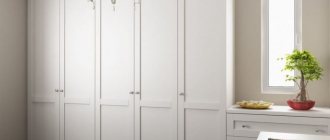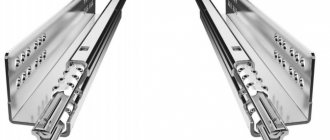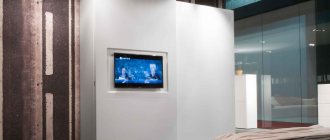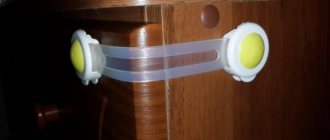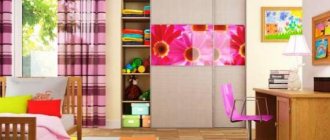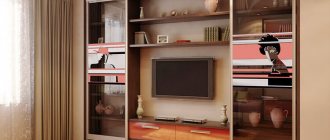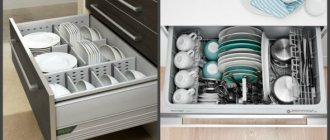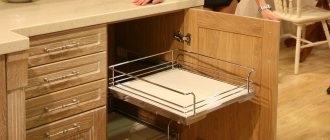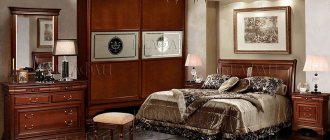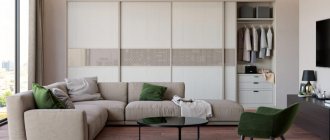Good day everyone and have a good spring mood! I think you will agree that drawers in a wardrobe are sometimes a necessity.
These are sections that are part of the filling of the wardrobe, which are installed inside the furniture and can be rolled out of it, opening the main doors. This simplifies access to the contents in the depths of the cabinet.
But in order for everything to work clearly and efficiently, you need to understand what types of boxes there are, how they are installed and what else should be taken into account, how to install such elements.
What size can you make a closet?
When making calculations, first of all, they proceed from the size of the room or part of the space (say, a corridor or hallway) that they decided to allocate for a built-in closet.
However, there are several significant aspects that need to be taken into account. Depth The standard depth of a wardrobe with hinged doors is 60 cm. This is enough for hangers with clothes to fit freely on a regular longitudinal rod: for a convenient arrangement of outerwear, at least 55 cm is required, for light clothing - 5 cm less. If it is a closet with sliding doors, you need to add another 10 cm - that’s how much the “compartment” design will “eat”. Width The minimum width of the cabinet is not regulated, but there is no point in making it less than 40 cm - otherwise boxes with shoes will not fit. In a cabinet with a depth of less than 50 cm, you will have to replace the longitudinal rod with end rods. Calculate their number correctly: on average, 8 hangers are placed on a 40-centimeter end rod.
Non-standard solutions for dead-end and narrow hallways and corridors
Sometimes the type of corridor sets a different direction for the cabinet being designed. A long, narrow, dead-end corridor is often shortened to create a built-in closet. This option may be more economical, since all structures are attached directly to the walls of the niche. To create it, you will need guides for doors, the doors themselves, the number of which directly depends on the length of the cabinet, various additional structures, fasteners for shelves, rods and racks, as well as other accessories.
Options for cabinet sizes depending on the number of doors and contents
The height of the built-in wardrobe in this case will depend on the ceilings of the room. Sliding doors will also be designed to fit the existing distance from the floor to the flow. The implementation of such a project can really be the right decision if you use the internal space correctly.
How to plan the interior space of a closet?
Designers recommend that before planning your closet, make a list of all the things that you will store in it, and then add another 20% “for the growth of your wardrobe.” Decide what will go on the shelf or in baskets (knitwear) and what will hang (pants, jackets). And how many things do you have in each category? Decide on the price: the internal filling of the cabinet can vary greatly in cost. Therefore, limit the budget you plan to meet in advance.
Longitudinal and end rods
Clothes hanging on hangers will take up the largest compartments. For women's clothing, we plan a box with a height of 150-160 cm. If long men's coats or raincoats will hang in the closet, set a height of 175 cm. Estimate at least approximately the number of items of clothing that will hang on hangers. You can put 5 cm on each hanger - this will be the width of the compartment (and the length of the longitudinal rod).
If you have a narrow closet with end rods, allow 60 cm of the width of the compartment on each hanger. There are usually not many end hangers - 2-3 pieces. Sometimes it’s worth making separate boxes with a bar for short items: skirts, trousers, shirts and blouses. They require a smaller height - 80-100 cm, which means they save space.
If men's trousers are hung without bending, allow 120 cm in height for them.
If you require a longitudinal rod length of more than 120 cm, provide a vertical support rod in the middle. It is positioned between the upper and lower partitions and is connected to the horizontal rod with a special coupling. This is necessary so that the longitudinal rod does not bend under the weight of things. If heavy things are hanging on hangers - fur coats, coats - the length of the bar without support should not exceed 100 cm.
Another important nuance: if the wardrobe is not built into a niche, but has side walls, do not plan a compartment with a rod immediately behind the outer wall. Make better ordinary horizontal shelves there. Sliding doors, rolling back and forth, push the side wall, creating an impact load. Horizontal shelves located close to the side plate will connect it with the rest of the supporting structures of the cabinet. One barbell will not provide such a strong connection.
Bar with lift (pantograph)
A pantograph is a special device that allows you to lower and raise a barbell. Such designs are quite expensive, but are indispensable in tall cabinets when you have to use space right under the ceiling. The pantograph will lower jackets and skirts directly into your hands, and then again remove the bar with things to an unattainable height.
Shelves Built-in wardrobes are ordered not only for clothes. On open shelves you can store almost everything (except for what needs to be hung): bed linen and knitwear, books and dishes. For clothes, you can use long shelves (80-120 cm), and for heavy books and dishes, the length of the shelf should not exceed 80 cm. A convenient distance between shelves is at least 40 cm.
If you are making a shelf longer than 80 cm, provide a vertical partition underneath it as additional support. Otherwise, the shelf may bend during use. In addition, the shelves are suitable for storing neatly folded jeans, bags, jewelry boxes, and hats. So make more shelves - they will all come in handy.
Special shelves
Wide shelves are designed at the top of the closet for blankets, rugs and bed linen. In addition, it would be nice to provide compartments for sports equipment. Think about what exactly you will store there. Four pairs of roller skates? Tennis rocket? Yoga mat? It is better to measure especially large devices in advance. At this moment you understand the advantage of a chess player over a bodybuilder. In addition, at the very top there is usually a large long shelf for suitcases, bags and travel equipment. Height - 45-50 cm.
DIY drawer
The assembly of the box is largely determined by the individuality of the craftsman who chooses certain tools. That is why all existing instructions will differ from each other in one way or another. Some craftsmen use templates, some do not, some craftsmen work only with clamps, and some consider them a waste of time.
In this regard, the sooner you develop your own manufacturing style, the better it will affect your work.
Available materials
To install the drawer you will need the following tools:
- laminated chipboard (chipboard);
- drill and screwdriver (you can choose one);
- hexagon;
- drill;
- self-tapping screw;
- guides;
- awl;
- measuring square;
- ruler;
- pencil.
Step-by-step instruction
Step 1. The first and one of the most important stages in making a box is the correct marking. In order for the parts to connect, the conformation must be located in two places - below and above.
There should be two holes for future screws, as well as markings
The holes should be equidistant from the edges of the side panel
Step 2: Take a 50mm template and make a mark on the top and bottom of the board. It is not recommended to measure less than 50 millimeters, since the fittings can split the chipboard.
When creating a box, you can work without a template, but it greatly simplifies the work
Step 3. Measure half the thickness of the material from which you are assembling the box. For such purposes, it is also convenient to use a template. Repeat this procedure for the top and bottom marks.
The template performs several useful functions at once when making a box
Step 4. To prevent the drill from going away during work, tap a hole at the intersection of the two marks using a screwdriver or any other sharp object.
The hole will be needed for further drilling with a drill.
Step 5. Align the parts of the future box using a template.
Before using the drill, make sure the sides of the box are not warped.
Step 6. Take the drill and press its tip into the indentations already made to fix the tool. While drilling, try to hold the drill straight so that the hole left by it will help the guides fit correctly.
You need to drill the hole gradually so that it comes out neat.
Step 7. Insert the screwdriver into the conformat bit, then insert the conformat itself and position it in place of the hole, smoothly placing it into the recess. If you find that the box has become skewed while placing the conformat, press it out using a hand hexagon and straighten the sides, then clamp it back. To avoid inconvenience, you can use corner clamps, which will immediately give the box the correct angle of inclination.
Insert conformat into the hole made
Step 8. Turn the box over and do the same procedure with the second hole.
Repeat with the second mark
Step 9. Once all other sides of the box have been drilled using the same method, check the diagonals to make sure they match each other.
The side panels folded together should be perpendicular to each other.
Step 10. Screw the bottom to the box, first leveling it. You can use an MDF board (six) as the bottom. If desired, the plate can be coated with enamel.
Fiberboard is often used as a bottom for drawers
Video - How to assemble a drawer
How to keep your shelves tidy?
Clothes can slide off shallow shelves, but on long shelves they quickly turn into a shapeless heap. To prevent this from happening, make small shelves with a side or divide a long rack into separate square cells: this way, each stack of clothes will have its own cell. Maintaining order will become much easier. Another way to organize the contents of open shelves is to put everything in boxes.
Roll-out shelves
Roll-out shelves are more convenient than fixed ones - they make it easy to find and get what you need. And the distance between them may be less than between ordinary ones. True, convenience does not come cheap.
Drawers Drawers are also much more convenient than their stationary counterparts - they allow you to easily view the contents. And besides, they save cabinet space: the height of a standard drawer is 20-25 cm, the height of a shelf is 35-40 cm. The drawers better protect the contents from dust. They have one downside - they cost significantly more than shelves, so it makes sense to use them locally: for all sorts of small things that are inconvenient or impractical to store on shelves: hats, gloves, scarves and other accessories. For stockings, socks and underwear, shallow drawers are used - about 12 cm high. The most convenient drawer models are those with a transparent front wall. They allow you to see the contents of the drawer without pulling it out.
When designing a drawer and calculating its width, be sure to take into account the width of hinges on swing doors and door joints in wardrobes. If the drawer is made to the full width to the maximum, it may simply not slide out.
Organizers
Drawer dividers and organizers help prevent chaos. They can be built into the box, or they can be sold separately from it. If you hate piled-up laundry, it’s better to invest in this additional option and enjoy putting your socks into bins. Like solitaire.
How to store shoes? Special inclined shoe shelves are a very convenient way to store shoes and boots. Alas, such shelves are not very spacious. It is more rational to divide shoes into two parts: those that are worn now, and those that need to be stored - seasonal, elegant, for special occasions. Leave what you need on the shelves, and put the rest in boxes and put them in the far corners of the closet. Shoe shelves are usually designed at the bottom of the closet. Their standard length is 80-100 cm.
If shoes and bags play an important role in your life, you can allocate each item a separate place in the closet.
How to properly arrange a mezzanine?
Mezzanine is a separate space at the top of the cabinet. It’s not so easy to get there, so basically the mezzanine functions as a storage room: seasonal items and sports equipment, suitcases and dresses that “I’ll wear when I lose weight” are put away here. Inside the mezzanine, as a rule, there are no additional compartments and drawers. If the height of the cabinet allows it, you should not add separate doors to the mezzanine - this will only increase the cost of the cabinet. A separate sliding door will be especially expensive, so if you have to, it’s better to make it hinged or folding.
Storage system zoning
Regardless of the configuration, any product inside is divided into conventional horizontal zones. As a rule, there are three of them.
- The lower zone is a compartment located below eye level and arm's length. Usually reserved for placing shoes, bed linen (in the bedroom or nursery), suitcases, bags or sports equipment. Here you can store any heavy items whose weight cannot be supported by the upper tier. Placing standard shelves for things in this area is not very convenient, because you will have to constantly bend over to get them, so drawers and pull-out baskets are suitable for filling.
- The middle one is the main part of any closet. This includes everything that is at eye level and that is easy to reach. Therefore, in the middle part there are hangers, shelves and hanging organizers for clothes and linen, which are used constantly. They should always be easy to access and this area should be well lit.
- Upper - the remaining space at the top is allocated for mezzanine shelves, which may not be as easy to reach as things in the middle zone. Most often, this part is used to place seasonal clothing, spare sets of underwear, hats and everything that is rarely worn and, therefore, taken out.
Instagram @bodes_studio
Unsplash
Instagram @jo.marie_b
- Storage systems
How to properly plan a closet from IKEA and more: 6 steps
Sliding wardrobe or wardrobe with hinged doors?
It is not necessary to hide the contents of the sections behind large monolithic doors.
Each section and block can have its own separate swing doors. In this case, the drawers will become part of the facade. You will get quick access to things, and the front will look more interesting - if, of course, you have planned the design aesthetically. Shelves and drawers hidden behind large doors can be arranged based solely on logic rather than aesthetics. Additionally, keep in mind that wardrobe doors “eat up” 10 cm of space, while a hinged door is only the thickness of a chipboard or MDF board (10 or 18 mm).
And most importantly, solid facades will cost less.
Recommendations for selection
Good furniture with a high-quality sliding mechanism lasts for years. There are several criteria to consider when purchasing. To properly arrange cabinets, you need to take into account the layout of the room. Before buying furniture, you should consider in advance what will be stored in it.
Special attention is paid to the quality of the fittings, as this is the weakest part of the furniture. If it is made of cheap material, it will break quite quickly. You can’t save money here; you need to purchase durable fittings made of stainless metal. The thickness must be at least 1.5 mm.
Good furniture with a high-quality sliding mechanism lasts for years.
When purchasing, you should pay attention to the operation of the guides (retractable mechanism). The boxes should move silently and smoothly. The creaking and crackling of the mechanism should alert you, this indicates that it is made skewed.
Poor installation of guides will lead to rapid wear and spoil the appearance of the furniture. There should be no scratches, chips or abrasions on the lining of the product.
Mirror, plinth and lighting
Mirror The most popular way to place a mirror in a closet is to make the doors mirrored. You can cover the closet with mirrors completely or partially. It is ergonomic: the mirror does not take up additional space, and reflective surfaces add shine, light and volume to the interior. If you are not a fan of large mirror surfaces in the interior, mirror the inner surfaces of the doors. True, this method is only suitable for swing structures. Two open doors with mirrors inside will provide the effect of a dressing table: you can see yourself both in front and behind.
Base
This element of the built-in wardrobe is useful if you have an uneven floor, which means there may be problems with doors mounted to the very bottom. Coupe doors will slide downhill, and you won’t be able to install a guide on bumps. Swinging doors can also warp, in addition, there will be unsightly gaps between the door and the floor. The plinth allows you to level the lower level of the cabinet, eliminating these problems.
Lighting Additional lighting of the closet is effective, practical, but not at all necessary. Using lighting, you can make open shelves more interesting and the space behind glass doors more mysterious. After all, illuminated shelves make it easier to find what you need. Mounting lighting inside sections makes sense if you have open shelves and want a beautiful decorative effect. Lighting hidden inside one shelf will not reach another compartment. If you want to illuminate the contents of the closet so as not to rummage through things in the dark, install lamps in the canopy. Don't forget to leave a gap between the canopy and the top border of the swing doors so they don't get caught. The transformer for built-in lamps is usually installed on the roof of the cabinet.
How can you reduce the cost of a built-in wardrobe?
Reducing the price of a cabinet is, of course, a way of compromises, but not all of them will be painful for you. So what can you give up? If you are planning a wardrobe, replace the expensive aluminum system with a cheap steel one. It is, of course, less reliable, but if you do not look too far ahead, it will do just fine. The service life of an aluminum system is 20 years, while that of a steel system is on average 5-7. Well, the steel one is noisier. Another saving resource is the number and design of doors. If you replace narrow doors with fewer wide ones, it will be cheaper. In some places you can abandon doors altogether - make a combined façade with open shelves or install hinged doors instead of compartment doors.
You can reduce the cost of a cabinet by using the materials used. Instead of the expensive chipboard that goes on the facade, use a white or thinner board inside. It is usually significantly cheaper. If you plan the shelves correctly, their load-bearing capacity will not deteriorate. Full-extension drawers are convenient, but quite expensive. You can replace ball bearing guides with roller guides. Yes, the drawers will not slide as smoothly and they will not be able to be pulled out completely, but this is not always important. Or give up drawers in favor of regular shelves.
You can save on shelf fastenings. Instead of invisible eccentrics that pull shelves and sides together, use regular corners. In essence, there are no inconveniences from them - on the contrary: if you want, you can rearrange the shelves differently. The only case when it is impossible to refuse eccentrics is when the shelves serve as stiffening ribs that hold the cabinet structure, for example, in the outer section with an open, non-built-in side panel.
Information provided by the site mebeldok.com
